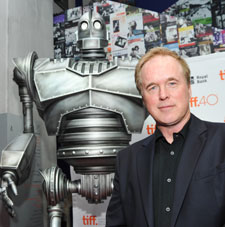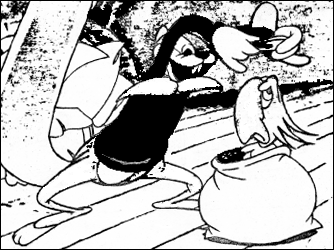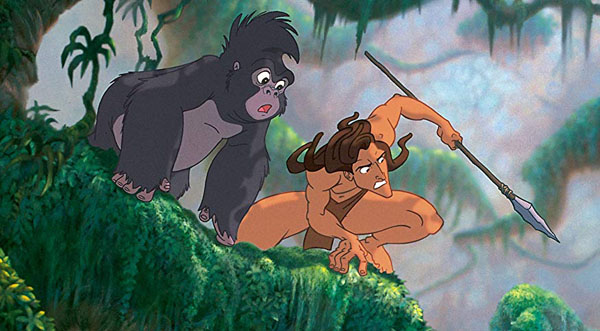 Anastasia. From the Daily News November 18th, 1997, Anastasia (1997) director Don Bluth said, “The idea started with Bill Mechanic, chariman and CEO of Fox Filmed Entertainment who suggested doing an animated version of My Fair Lady. I and Gary Goldman felt it would be impossible to improve on the live action film but took the Pygmalion idea of molding a regal woman from an ordinary girl and came up with Anastasia. Fortunately, Fox still owned rights to the story and the title thanks to their 1956 live-action film.
Anastasia. From the Daily News November 18th, 1997, Anastasia (1997) director Don Bluth said, “The idea started with Bill Mechanic, chariman and CEO of Fox Filmed Entertainment who suggested doing an animated version of My Fair Lady. I and Gary Goldman felt it would be impossible to improve on the live action film but took the Pygmalion idea of molding a regal woman from an ordinary girl and came up with Anastasia. Fortunately, Fox still owned rights to the story and the title thanks to their 1956 live-action film.
“When we began researching, we said, ‘We can’t really tell the story of the Romanovs and the whole documentary because it’s just too dark’. So we said, ‘Why don’t we take all these facts that we know and base it as much as we can on what happened in real life but let’s tell a myth or a fairy tale’. However, as with any feature length animated film, people are going to think it’s Disney.
“I think Disney is not going to let go of their stranglehold on animation without some kind of struggle and it’s natural that they would try everything they can to tell the world, ‘We’re the only ones who can do this. No one else has the ability’.
“Animation as an art form needs variety. To simply say that, within the confines of the corporate walls called Disney, that’s the only place that this art can grow, I think is an immature postion.”
 Brad Bird. From Los Angeles Times June 1st, 1997, director and animator Brad Bird who was then working on Iron Giant (1999) said, “You need to be careful that marketing does not get in the way of the actual film. The amount of money spent is so astronomical and you have to make the deals so far in advance, the movie is not always the first priority. You have to make sure the merchandise doesn’t dictate what kind of entertainment we make.”
Brad Bird. From Los Angeles Times June 1st, 1997, director and animator Brad Bird who was then working on Iron Giant (1999) said, “You need to be careful that marketing does not get in the way of the actual film. The amount of money spent is so astronomical and you have to make the deals so far in advance, the movie is not always the first priority. You have to make sure the merchandise doesn’t dictate what kind of entertainment we make.”
Don’t Walk. In 1996, residents of Bristol, England objected and eventually rejected the proposal to name two cul-de-sacs on a new Bristol estate Wallace Walk and Gromit Grove to honor hometown boy Nick Park’s Wallace and Gromit characters.
Wyrd Sisters. Wyrd Sisters was a six part animated television series based on the books by Terry Pratchett. It was produced by Cosgrove Hall Films and was broadcast in May 1997. It told the story of three witches: Granny Weatherwax, Nanny Ogg and Magrat Garlick.
Pratchett said, “It’s a feast of fun for all the family. The animation is incredible. I was shown several versions of one episode and they just kept getting better and better. A lot of effort has gone into it. When a character takes a deep breath, it’s so lifelike it makes me cheer out loud.
“I had several discussions with the animators about the clothes the characters should wear – but it was mostly a case of fine-tuning. We talked a lot about Granny Weatherwax’s boots, which should look like they came from a Victorian farm. In fact, she looks like a cross between a 19th century farm worker and Clint Eastwood’s nanny!”
 Wisdom of Katzenberg. On July 26, 1988, after a 22 week walkout by striking writers that was not particularly successful, producer Jeffrey Katzenberg told them that they should be more trusting of producers. He said, “We may be incompetent. We may be stupid. We may have bad taste. But we are not crooks.”
Wisdom of Katzenberg. On July 26, 1988, after a 22 week walkout by striking writers that was not particularly successful, producer Jeffrey Katzenberg told them that they should be more trusting of producers. He said, “We may be incompetent. We may be stupid. We may have bad taste. But we are not crooks.”
The Great Muldoon. In 1958-59, the William Morris Agency developed a television pilot called The Great Muldoon. The producer was John Sutherland. The announcement said, “This is a comedy mixing live action with animation and follows the adventures of a cartoonist and his creation, The Great Muldoon.”

Lost Cartoon. Squirrel War released in 1947 was one of the last films produced by Anson Dyer, the English animation pioneer. It was actually a three part cartoon serial made specifically for Saturday morning cinema clubs that sought to bring their young audience back to the theater the following week. The three segments were entitled The Doll’s House, The Storm, and Springtime and each ran approximately ten minutes each.
Films Never Made. In Variety for August 26th, 1991, Hugh Shirley of Huggieland (based in Winnipeg, Manitoba) was looking for animated talent to work on three feature length animated films that had supposedly already commenced production: Peter Pan Returns “to visit Nancy’s children. Peter has wed Tiger Lilly and their son, Peter Pan Jr. takes all of Nancy’s children back to Neverland”; Pinocchio Weds Penalomaria, in which “Papa Gepetto carves Pinochhio a sweetheart and they live happily ever after; and finally Snow White and Prince Charming “where the seven dwarfs have married and have many children but the wicked witch survived her fall and is still trying to get even. She has also married and her children are just as bad as she is.”

Tarzan Score. From The Hollywood Reporter November 6, 1997, composer Alan Silvestri whose credits include Forrest Gump and the Back to the Future trilogy and was then working on Disney’s animated feature Tarzan (1999) stated: “I need to work harder than I would on a live-action feature. You do not write down for animation. As a matter of fact, the music needs to be as emotionally powerful as it can be, because even more so than with live action, music is casting a spell.
“If you break that spell, you’re betraying the audience, and instead of a wonderful piece of storytelling unfolding on a screen, suddenly you’ve got 650 strangers sitting in a dark room. Music is a huge part of the illusion in animation.
“Tarzan is absolutely as satisfying a project as any I could have taken on. The greatest challenge in scoring feature animation is that the music must be playful enough to accompany comic action while maintaining enough emotional depth to help power the story along.
“When you are looking at creatures that can do physically impossible things, you have the opportunity to do some unique things musically. But sometimes you have to resist the urge, because ultimately you want an audience to really care about the characters and their stories. You don’t want to play into the cartooniness as much as you want to push the drama.”
(Note: The final instrumental film score for Disney’s Tarzan was composed by Mark Mancina).


 Jim Korkis is an internationally respected animation historian who in recent years has devoted his attention to the many worlds of Disney. He was a columnist for a variety of animation magazines. With his former writing partner, John Cawley, he authored several animation related books including The Encyclopedia of Cartoon Superstars, How to Create Animation, Cartoon Confidential and Get Animated’s Animation Art Buyer’s Guide. He taught animation classes at the Disney Institute in Florida as well as instructing classes on acting and animation history for Disney Feature Animation: Florida.
Jim Korkis is an internationally respected animation historian who in recent years has devoted his attention to the many worlds of Disney. He was a columnist for a variety of animation magazines. With his former writing partner, John Cawley, he authored several animation related books including The Encyclopedia of Cartoon Superstars, How to Create Animation, Cartoon Confidential and Get Animated’s Animation Art Buyer’s Guide. He taught animation classes at the Disney Institute in Florida as well as instructing classes on acting and animation history for Disney Feature Animation: Florida.




















































Based on Hugh Shirley’s synopses, it’s probably best that the Huggieland animated features were never made.
Bluth’s comments about animation needing variety are interesting, considering that his own films mostly follow the Disney formula in both visuals and subject matter. And yet a closer look reveals that he at least attempts to go beyond typical cartoon fare. The Secret of NIMH has more in common tonaly with ‘70s sci-fi thrillers than the usual Disneyesque romp; Dragon’s Lair and Space Ace, being arcade games aimed at teenagers, have more violence and sexuality than the rest of Bluth’s work; All Dogs Go to Heaven is partly a ‘30s gangster film; and Titan AE really earns that PG-13 rating. Hell, he and Joss Whedon were even going to do a Dracula musical at Fox!
Squirrel War is NOT a lost cartoon, Jim. All three parts are available in British prints. I have a black and white print of what I remember as all three parts spliced on to one reel. I’m not sure if these were made in colour (note British spelling) or black and white. They have nice 1940s character design. The animation is OK, not as good as David Hand’s GB animation unit turned out, such as the Animaland series.
“…producer Jeffrey Katzenberg told them that they should be more trusting of producers. He said, “We may be incompetent. We may be stupid. We may have bad taste. But we are not crooks.””
Except for that last sentence, I think I agree with Mr. Katzenberg here!